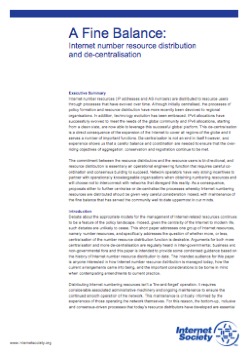 Have you ever wondered about how IP addresses get distributed to Internet Service Providers (ISPs) and other network operators to give out to you in your home or office? Regardless of whether for IPv6 or legacy IPv4 addresses, would you like to know more about how that process actually works?
Have you ever wondered about how IP addresses get distributed to Internet Service Providers (ISPs) and other network operators to give out to you in your home or office? Regardless of whether for IPv6 or legacy IPv4 addresses, would you like to know more about how that process actually works?
In April 2013, some of our colleagues here at the Internet Society authored a white paper exploring these exact topics. Titled “A Fine Balance: Internet number resource distribution and de-centralisation“, the document has this for an executive summary:
Internet number resources (IP addresses and AS numbers) are distributed to resource users through processes that have evolved over time. Although initially centralised, the processes of policy formation and resource distribution have more recently been devolved to regional organisations. In addition, technology evolution has been embraced. IPv4 allocations have successfully evolved to meet the needs of the global community and IPv6 allocations, starting from a clean slate, are now able to leverage this successful global platform. This decentralisation is a direct consequence of the expansion of the Internet to cover all regions of the globe and it serves a number of important functions. Decentralisation is not an end in itself however, and experience shows us that a careful balance and coordination are needed to ensure that the over-riding objectives of aggregation, conservation and registration continue to be met.
The commitment between the resource distributors and the resource users is bidirectional, and resource distribution is essentially an operational engineering function that requires careful co-ordination and consensus building to succeed.Network operators have very strong incentives to partner with operationally knowledgeable organisations when obtaining numbering resources and will choose not to interconnect with networks that disregard this reality. As a consequence, proposals either to further centralise or de-centralise the processes whereby Internet numbering resources are distributed should be given very careful consideration indeed, with maintenance of the fine balance that has served the community well to date uppermost in our minds.
The document goes on to explain how IP address allocation began and how it evolved to the current model. It is well worth a read for anyone seeking to better understand how the Internet really works at an operational level.
